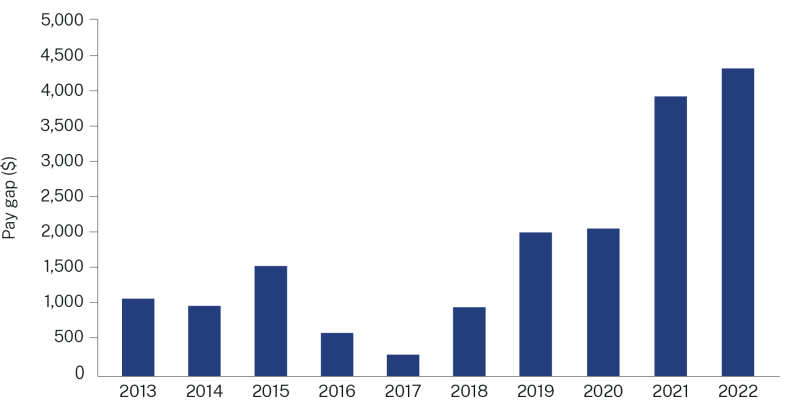Download or print
Request accessible format of this publication.

Work that has traditionally been considered ‘women’s work’ contributes significantly to employment, economic growth and broader wellbeing across New South Wales.
Feminised industries are industries that are female-dominated and often associated with caring. The feminised health, social assistance and education industries provide essential social infrastructure to individuals and communities. They also support women, who disproportionately provide unpaid care, to engage in paid work.57
Feminised industries have, however, been historically undervalued.58 Analysis by Impact Economics and Policy found that employees with a bachelor’s degree or higher working in female-dominated industries earn 30 per cent less per hour than equivalently qualified employees in male-dominated industries.59 Similarly, employees with a Certificate III/IV working in female-dominated industries earn 36 per cent less per hour.60
The Fair Work Commission has accepted that undervaluation in the aged care sector stems from social norms that have impacted the assessment of work value.61 Specifically, it noted that women’s disproportionate engagement in unpaid care has contributed to the invisibility and underrecognition of skills described as creative, nurturing, facilitating or caring in paid labour.62
The Fair Work Commission recently found that existing minimum award wage rates do not properly compensate care workers in either residential or in-home aged care settings for the value of the work performed.63 The Commission decided to increase minimum wages by 15 per cent from 30 June 2023 for direct care employees working in aged care.64

pay increase for more than 400,000 public sector employees (incl. super)
The undervaluation of feminised industries should not be an accepted element of the economy. It entrenches gender inequality within the labour force and society more broadly. The NSW Government is the largest employer in Australia, and women make up 66.3 per cent of the NSW public sector workforce.65 The Government is committed to leading by example in supporting feminised industries.
The NSW Government has abolished the public sector wages cap and is bringing a new approach to wage negotiations. The Industrial Relations Taskforce, led by former Deputy President of the Fair Work Commission, Anna Booth, and former President of the Industrial Relations Commission, Roger Boland, has been established to fulfil the Government’s commitment to a new interest-based bargaining framework.
In June 2023, the NSW Government took the first steps towards recognising the valuable work of our essential workers with the largest pay rise in more than a decade. The 4.5 per cent pay increase (including a 0.5 per cent increase to superannuation) for more than 400,000 public sector employees was just the beginning of a long-term plan to support higher wage rises and rebuild essential services.
A historic pay rise will see teachers go from being among the worst to the best paid in the country. Starting salaries for teachers will increase from $75,791 to $85,000, and salaries for those at the top of the scale will increase from $113,042 to $122,100. All teachers will benefit from the restructuring of the pay scale.
A flat rate pay increase of $3,500 for more than 50,000 healthcare workers, of which a majority are women, will lead to lower paid staff receiving a pay increase as high as 8 per cent.
A focus for the NSW Government will be how to reduce the gender pay gap in the NSW public sector. In June 2022, the gap in median remuneration between men and women in the NSW public sector was 4.5 per cent, compared to 4.1 per cent in 2021.66 This is the highest median gender pay gap in the past decade for the NSW public sector (Chart 3.1).67
Chart 3.1: Difference in remuneration between males and females in the public sector


hour reduction per week in teachers’ administrative workloads

of the NSW education workforce are female

of school teachers are women
The education sector is the largest contributor to female employment in the NSW public sector. In 2022, women made up 76.8 per cent of the NSW education workforce and 77.8 per cent of school teachers.68 By supporting teachers, the NSW Government is supporting thousands of women across the State.
Investing in teacher quality and effectiveness will support teachers to improve student outcomes. The evidence shows that, within schools, teaching practice is the most significant driver of student outcomes.69 Improved student performance can lead to improved labour force productivity and economic growth.70 Better education also contributes to broader wellbeing, improved health and reduced crime rates.71
An increasing administrative workload is reshaping the work of NSW teachers and pressures they face.72 The NSW Government has committed to reduce teachers’ administrative workloads by at least five hours per week, enabling teachers to focus on teaching and ultimately on delivering better outcomes for NSW students.
The NSW Government has offered permanent roles to 16,000 temporary teachers and school-based support staff, the majority of whom are women. All of these offers have been accepted. This initiative will provide greater job stability and financial security, including helping women to secure finance. It will also support job retention.
A $20.0 million Innovative Teacher Training Fund will develop new and innovative pathways into teaching by providing additional support to pre-service teachers and ensuring access to in-class training and support.
Women hold the majority of teaching positions, but are underrepresented in school leadership roles. While 77.8 per cent of teachers are women,73 only 70.8 per cent of primary school principal positions and 52.5 per cent of secondary school principal positions are held by women. The NSW Government is considering how to address this gender disparity.

of all NSW midwifery and nursing professionals are female

healthcare students supported with scholarships

new nurses and midwives

full-time equivalent nurses and midwives funded on a temporary basis to be made permanent
Midwifery and nursing professionals make up almost half of all health professionals in New South Wales.74 Like teaching, the profession is heavily gender segregated. Women currently comprise approximately 89.8 per cent of all NSW midwifery and nursing professionals.75
Health workforce supply is an ongoing challenge, largely driven by evolving population health needs, consumer expectations, technological advancements, and changing workforce and workplace expectations.76 According to the 2022 Skills Priority List, registered nurse, enrolled nurse and nurse practitioner occupations are in shortage in New South Wales, and at a national level have been assessed as facing strong future demand.77
This demand, however, comes at a time of increased competition in the labour market and health workforce fatigue following the COVID-19 pandemic. While the COVID-19 pandemic has reinforced the importance of nursing, like other care professions, nursing has historically tended to be undervalued and seen as ‘women’s work’.
This gender bias negatively impacts women but also makes it challenging to recruit men into the profession.78 Only 10.2 per cent of midwifery and nursing professionals are men.79 Men currently make up 18.3 per cent of Vocational Education and Training student program enrolments in the nursing field of education80 and 13.6 per cent of university commencements in special nursing courses.81 The nursing profession should reflect the diversity of our State, because an inclusive nursing workforce produces better health outcomes.82
The NSW Government is committed to attracting and retaining a diverse nursing workforce. This Budget commits $121.9 million over five years to support 12,000 healthcare students with study subsidies. New students from 1 January 2024 will receive scholarships of $4,000 per year. Existing students will receive one-off payments of $8,000. Students must make a five-year commitment to the NSW public health system. The intent of this policy is to incentivise students of all genders to enter the health workforce.
The NSW Government will invest $419.1 million for an additional 1,200 full-time equivalent nurses and midwives to support the implementation of Safe Staffing Levels in NSW public hospitals. This Budget also commits $572.3 million over three years to enable 1,112 full-time equivalent nurses and midwives employed on a temporary basis to be made permanent. These measures are intended to achieve better health outcomes for patients and improve the experience of nurses, midwives and patients in the NSW health system.
While recruiting more men into nursing is a priority, consideration will need to be given to the progression of men and women in the profession. A global study of leadership in nursing describes a ‘glass elevator’ for men who hold a disproportionately high number of senior nursing roles worldwide.83 In New South Wales, men make up 30.3 per cent of nurse managers despite only making up 10.2 per cent of midwifery and nursing professionals.84
The social and community sector refers to the section of the labour market focused on assisting people with their everyday functioning and care needs. It includes aged care, early childhood education and care, community mental health, disability care, child protection, housing and homelessness services, and domestic violence support services.85
Approximately 75 per cent of the social and community service workforce are women.86 Average wages are low compared to other sectors, and it is estimated that 50 per cent of the workforce are employed as casual or fixed-term staff rather than as permanent, ongoing staff.87 In a recent survey, 53 per cent of NSW social sector employees surveyed cited low pay and/or insecure work as career impediments.88 Half of surveyed employees reported they were either planning to leave the sector or were not sure if they will still be in the sector in five years’ time.89
The NSW Government will establish a taskforce to deliver job security and funding certainty for the NSW community services sector. Specifically, the taskforce will consider four intersecting priorities:
The NSW Government is increasing grant payments to non-government organisations by the NSW Department of Communities and Justice and NSW Health. Payments will be indexed at 5.75 per cent for 2023-24 following the Fair Work Commission’s decision to increase award minimum wages by 5.75 per cent from 1 July 2023. This increase will enable non-government organisations to increase pay for staff while maintaining service levels.
The NSW Government will also engage with stakeholders, including unions and employers, about the best way to extend portable entitlements, including long service leave, to community service workers.
Request accessible format of this publication.